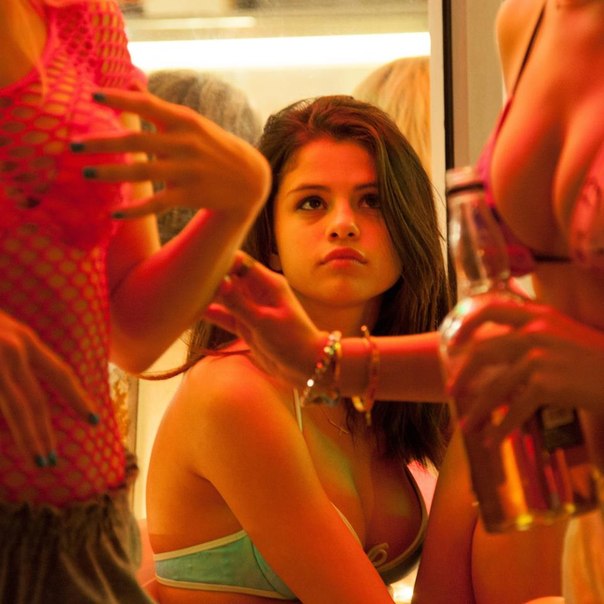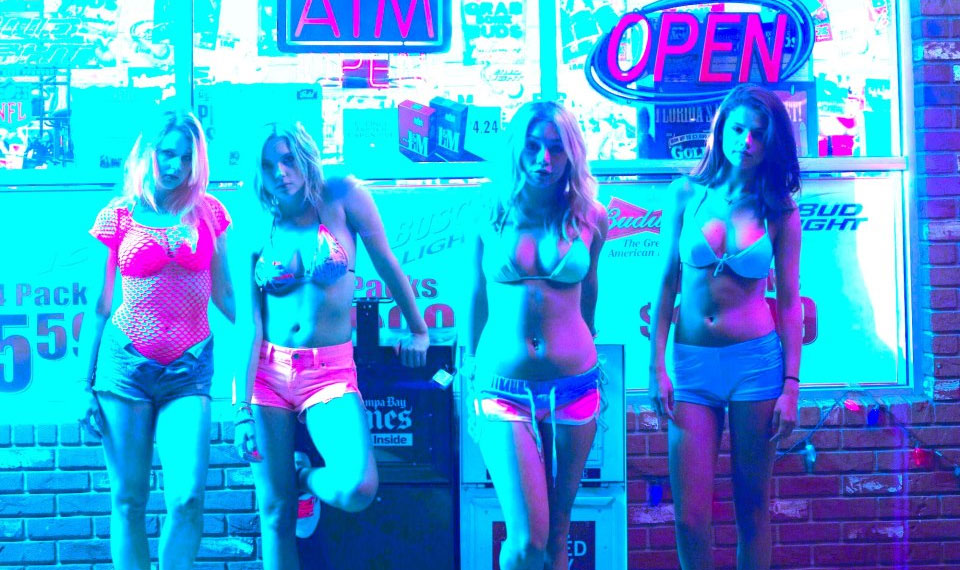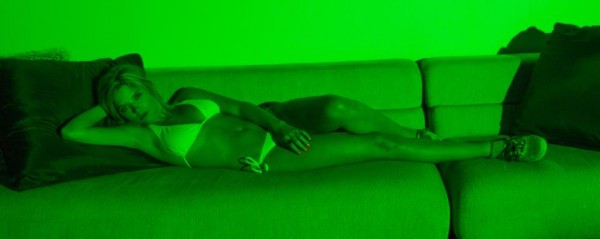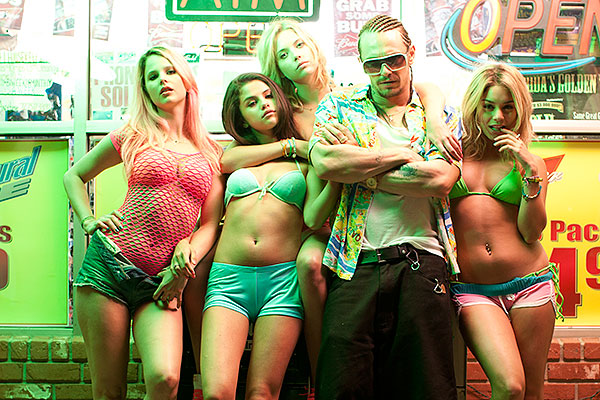Break Yo’self : SPRING BREAKERS (Part 1 of 3) – The Set Up & The Sensory
Part one of our 3 part analysis of Harmony Korine’s latest bold cinematic endeavor is all about bodies and body highs
The widespread theatrical release date for writer/director, Harmony Korine‘s latest film, Spring Breakers, fell on March 22nd. That afternoon, I went to see a matinee screening at an IMAX theater that’s across the street from a mall in North Seattle. It was an easy choice of location, both because of its proximity to my home and because it shares the last name of rapper, Kool Keith (“Thornton” Place). But the fact that any options in location were made available at all, came as a huge surprise; I pretty much expected to have to wait for it to play at the local film festival, and/or find a one-off screening at an independent theater, like I did for his last two feature film releases. Just days before, the only showings available in Washington State were listed at a place in Bremerton (if you don’t know where that is, then you get the point) and 2 screenings (10pm and midnight) the Thursday night before in Lynwood, which is about 20 minutes north of the city limits. Beyond that, there was absolutely nothing. Within the matter of a couple of days, there was huge growth in the level of distribution and the film was released in over 1,000 theaters nationwide. After its much smaller limited release, which consisted of only 3 theaters between Los Angeles and New York, Spring Breakers pulled in $270,000, making it the #1 grossing limited-release film of the year, to date. Whether it was part of the original plan or not, this was definitely incentive for A24 Films, the studio that acquired the movie’s domestic rights, to invest in multiple TV ads and push the distribution of what is, essentially, an art house film. I can not EVER recall seeing an advertisement for any Korine project on television before, aside from some select news coverage surrounding the “controversial” Larry Clark film KIDS (1995), which Harmony wrote the screenplay for back when he was in his late teens. There’s something different about this film, not only from the director’s previous work, but from anything else that you’re going to see this year — maybe, from anything else that you’re ever going to see again
Was the huge interest in the film and impressive initial ticket sales simply a result of Korine producing a far more accessible “Hollywood” movie, watered down for mass consumption? The majority of the people that have seen it would, undoubtedly, tell you that couldn’t be further from the truth. Do those numbers reflect that Spring Breakers is simply an unparalleled, cinematic triumph. That’s also doubtful, which is unfortunate, because I actually believe that it is, and I plan to elaborate on that reasoning as we move forward. One thing to keep in mind is that most of those early sales numbers would have to be credited to first time views and not so much to repeated customers, so that’s more of a reflection on what people came expecting to see and less of a reflection of how anyone felt about what they actually wound up attending. So, what did they come to see? What we know from the ads is that the film stars 4 relatively young females in bikinis. Aside from Harmony‘s wife Rachel Korine, 2 of them are girls which have a history on Disney Channel programs targeted to a younger demographic —Selena Gomez (Wizards of Waverly Place) and Vanessa Hudgens (Highschool Musical)– while Ashley Benson (formerly of Days of our Lives) stars on the ABC Family program Pretty Little Liars. The other primary character in the film is played by James Franco, who is also currently starring in the number 1 film in the country, right now, with the Walt Disney Pictures release, OZ, The Great and Powerful. Now, just add a soundtrack created by Skrillex and composer, Cliff Martinez (DRIVE), release the film over spring break, and all of that spells momentum. Next question: “Do I expect a major backlash on this film?” Answer: Definitely. But that’s just part of what makes this entire project so strikingly beautiful.
Perverts & Princesses
I got to the box office about 10 minutes before showtime and there was a man in his sixties who was buying a single ticket to the film in front of me. He resembled an older version of Philip Seymour Hoffman‘s character, “Allen,” the obscene phone caller, from the 1998 Todd Solondz film, Happiness, both in appearance and general vibe. He was clearly there for the Disney girls in bikinis. I asked the kid in the window if he had been selling a lot of tickets for Spring Breakers to men in their sixties, and he chuckled uncomfortably when he responded, “That was my first.” I remember seeing Solondz on a late night talk show (Conan?) around the time that Happiness was released and he said that, after anonymously sitting in on a screening, someone in the audience had said that whoever made the film should be shot. Spring Breakers is already receiving somewhat of a similar response, with many people claiming that it is the “Worst movie that [they’ve] EVER seen!” and that it was a terrible waste of their time and money. One of my favorite comments, so far, has been the following sentiment, delivered in broken English: “I wanna punch the director of movie on his face!” Apparently, the offensiveness of this project transcends cultural boundaries. One could argue that it also transcends cinematic boundaries. In fact, I should probably just come right out and admit that, throughout this analysis, I will be the one attempting to argue just that.
The flip side of the voyeuristic pedophile is the unassuming Hudgens and Gomez fan that seemed to believe that they were on their way to see their idols in a role that they could actually stomach. Aside from a group or two of young men that reeked of pot smoke (“spraaang breaaak, ya’ll!“), the theater was relatively empty, but two such mall girls did seat themselves only a couple of chairs down from me on my left. Whether or not they thought that these new “adult” roles were simply the equivalent of Anne Hathaway transitioning from The Princess Diaries to something like Les Miserables, I don’t know, but I find it hard to believe that they had much of an idea about what to expect. Maybe “unassuming” isn’t the best word, because assumptions and expectations are the mothers of disappointment, and there currently seems to be plenty of widespread disappointment being generated online. I didn’t experience any similar dissatisfaction, because my enthusiasm stemmed from not knowing what to expect, and that’s what Korine delivered; an entirely new cinematic experience that actually questions what constitutes cinema, while broadening the scope of what it is capable of, overall. From the moment that the opening sequence kicked in, I was locked into what unveiled itself to be a visceral, emotional roller coaster; completely engaged and affected by every twist, turn, or flash of light. And that first image was that of a hedonistic slow-motion beach party, complete with frat boys shaking up beer bottles like they were manhandling their erupting cocks and close-ups of bare, hypnotically moving tits. It was the first little key bump to get the senses rolling. The 2 girls next to me didn’t respond as favorably, already shifting uncomfortably in their seats. They each spent a good portion of the remaining film with their faces in their smart phones, texting and trying to avoid the movie altogether. For whatever reason, they still stayed to the very end. The older gentleman didn’t fair quite as long. He didn’t get what he expected either.
The Storyline

One of the major complaints that I’ve come across, regarding Spring Breakers, refers to the lack of storyline and, while I agree that the true strength of the film lies much more within the mesmerizing aesthetics and shifts in tone, served remarkably well by some brilliant editing and pacing choices, I don’t believe that it entirely abandons the idea of character development, or any semblance of narrative structure. The basic premise of the film revolves around 4 young girls who are hell-bent on making it out to Florida for spring break. Although they all have their own unique personalities, the primary motivation for this trip is summed up by Selena Gomez‘s character, “Faith,” the most reserved and “innocent” of the bunch, when she explains that it’s more about getting away from their stale boring lives and surroundings, than them going to any specific location. This movie is fueled by their individual desires to experience something “more,” so the fact that they opt for an environment with a limited amount of restrictions on their behavior is definitely a major factor in their decision making. Being short on cash, the other 3 females commit a robbery at a chicken shack to fund their mission, but are arrested for unrelated charges (drugs and partying) somewhat early on, while living it up in their dream destination. With the brakes temporarily put on their new-found, unrestrained freedom, the rapper/drug dealer/all-around hooligan, “Alien” (Franco) bails them out of jail and offers them an opportunity to get shit rolling at full speed again. The story unfolds from there and the debauchery continues, coasting on pure energy and setting off all manner of sensory triggers through a variety of refreshing approaches to cinematography, sound, lighting, and rhythm.

Some of the people that are disappointed by the fact that the movie is so sensory driven, are simultaneously complaining about the focus of the very storyline that they claim doesn’t even exists. Being that it is so image focused, the viewers own personal relationship with the imagery and the stimuli being presented is what will determine what they believe that this movie is “about.” In fact, it will likely even inform your opinion about what you believe Harmony Korine‘s goals and intentions are with making it in the first place. From the first seconds on the screen, when the tits and alcohol are flying around uninhibited, the viewer is going to instantly make an unconscious emotional decision, one way or another. Do you relate to the people being shown and do you want to be at that party? Is it a comical, stereotypical representation of how unapologetically hedonistic youth acts in this day and age? [From my understanding, none of the extras were even asked to get naked, only to do whatever they wanted and felt comfortable with. These choices were all their own]. Are you upset that there isn’t more T&A in the film or any real on-screen sexual penetration? Are you gonna hold firmly to your expectations, or simply let this ride take you where ever it’s naturally going to? There are definitely intentional plays on contrast and juxtaposition, such as having young girls in bikinis sporting childlike backpacks, but even those do not have defined, rigid interpretations; the discussion and determination about whether or not something like that is a symbol of childhood lost, or straight up erotica, is taking place in your own twisted skull. Some attacking this film believe that it’s clearly exploitative filth, or, as I’ve read somewhere, “a pedophiliac’s dream.” Others defend the film, claiming that it’s a satire and an indictment of vapid, hedonistic, youth culture. The truth of the matter is that it really isn’t either. It’s an experience, and it’s one where your interpretations of whatever you are witnessing are wholly your own and fairly automatic.
The Aesthetic

After Gummo was released in 1997, Harmony made an appearance on Late Night with David Letterman in which he stated that “bacon” was his “aesthetic.” For his new film, he explained to director of photography, Benoît Debie (Gaspar Noe’s Enter the Void) that he wanted it to appear as if it was lit with Skittles. What I experienced was a cross between a Lite Brite and those Magic Eye autostereogram images, like the one that the guy from My Name is Earl was desperately trying to see the sailboat in, in Mall Rats. Or, maybe, it’s more like using an infinity mirror as a surface for chopping rails of molly. Spring Breakers suspends the viewer and leaves them levitating like they’re in a sensory deprivation tank, or paralyzed by a tractor beam, but, while it has a hold of you, it unleashes an onslaught of images and various scenarios at your dome like Malcom MacDowell; Visine in the eyes and strapped into a theater chair. It takes you into its folds and makes you one with the film. Fuck 3D, which is essentially just 2-dimensional images appearing closer than they actually are; this movie is providing a 4-dimensional experience. It’s a lot closer to virtual reality, than the typical motion picture, which allows you to become a passive observer. Spring Breakers is an interactive experience that will completely envelope you, if you allow it to (and you most certainly should). Harmony Korine hasn’t so much created a film, this time around, as he has constructed a fully functional hypercube out of psilocybin-lacquered celluloid that melts on your tongue like a Fruit Stripe gum wrapper. [“Am I hypersensitive?“]
Depth of Feel

If there’s one line that best summarizes the entire project, it’s probably the one that comes from Candy (Vanessa Hudgens) right before the girls commit the chicken shack robbery with squirt guns: “Pretend like it’s a video game. Just act like you’re in a movie or something.” That logic represents a clear sensory and emotional detachment, or, at the very least, a soft focus on “reality” (whatever that is). The film, itself, exists on a similar plane, with light-to-medium surges of voltage pulsating throughout, stimulating the viewers senses like a body high. The robbery scene was surreal and wonderfully shot; the camera slowly panning around the perimeter of the building, as we watch from the getaway car, while the girls move from room to room, framed by the outside windows… like they were “in a movie or something.” [Another little key bump to the senses.] I felt a bit of euphoria during that scene. I actually got a rush from it… a smooth, tangible buzz. A very noticeable, physical high. But, that’s where the autostereogram effect comes into play, because when they flashback on the scene, later in the film, while utilizing a much more intimate perspective, that opiate-like scenario, becomes genuinely horrifying. Your perceptions about what is taking place are allowed to shift drastically and without warning. One minute you’re coasting and skimming across some fluorescent aura and then, the bottom falls out. The emotional depth of field (depth of feel?) is fluctuating in and out, shifting your perspective, along with the source of that perspective, back and forth, between external and more internal triggers. Like the film, its characters are motivated by feelings and energy, which have no level of “right” or “wrong” judgment placed on them. It’s like a video game, but one that occasionally comes unplugged, making things feel more grounded and cerebral. Washed out. Hungover. Almost abandoned. A cocaine party mutates into warped delirium and then straightens itself back out, mundane and flat as a balsa wood two-by-four.
 Alternately, moments of sheer innocence can feel corrupted by perversion. The girls frolic playfully in a dorm hallway and the camera creeps in, zooming down to hover around their nether regions. While in a pool with Candy and Brit (Benson), Faith is expressing her deep personal feelings, when the camera uncomfortably dips under water and pans to their young, scantily clad, nubile lower bits. The first-person point-of-view makes you feel like the deviant, but then the blame shifts immediately to Korine, the one “exploiting” these “poor, impressionable girls” to satisfy his own sleazy, detestable fantasies. [Of course they are all adults in their twenties on a movie set and one of them is even his wife, but… that doesn’t fit this angry, defensive narrative, where letters are written to studio heads and theaters are protested]. It may sound ridiculous to hear the characters speak of “finding” themselves through such debaucherous paths in such superficial environments, or to hear Faith, specifically, discuss it all within, what is almost, a spiritual context, but, if there’s anything that this film remains loyal to, it’s the ideas behind individual perspective and perception. Just because their actions could, arguably, be considered as superficial or shallow, that doesn’t mean that they aren’t driven by forces that are much deeper and more respectable. The characters in this film are typically motivated by a search for personal freedom, and it’s hard to argue that there is any goal much deeper, purer, or more innately human than that. Even when their methods may be questionable, their individual senses of self are still ultimately defined by where they eventually, discover their own personal limitations and boundaries, in the end.
Alternately, moments of sheer innocence can feel corrupted by perversion. The girls frolic playfully in a dorm hallway and the camera creeps in, zooming down to hover around their nether regions. While in a pool with Candy and Brit (Benson), Faith is expressing her deep personal feelings, when the camera uncomfortably dips under water and pans to their young, scantily clad, nubile lower bits. The first-person point-of-view makes you feel like the deviant, but then the blame shifts immediately to Korine, the one “exploiting” these “poor, impressionable girls” to satisfy his own sleazy, detestable fantasies. [Of course they are all adults in their twenties on a movie set and one of them is even his wife, but… that doesn’t fit this angry, defensive narrative, where letters are written to studio heads and theaters are protested]. It may sound ridiculous to hear the characters speak of “finding” themselves through such debaucherous paths in such superficial environments, or to hear Faith, specifically, discuss it all within, what is almost, a spiritual context, but, if there’s anything that this film remains loyal to, it’s the ideas behind individual perspective and perception. Just because their actions could, arguably, be considered as superficial or shallow, that doesn’t mean that they aren’t driven by forces that are much deeper and more respectable. The characters in this film are typically motivated by a search for personal freedom, and it’s hard to argue that there is any goal much deeper, purer, or more innately human than that. Even when their methods may be questionable, their individual senses of self are still ultimately defined by where they eventually, discover their own personal limitations and boundaries, in the end.
Electric Youth

I live incredibly close to the type of highway that’s scattered with beaten down streetwalkers, medical marijuana dispensaries, and cheap motels. If you head far enough in the right direction, you’ll drive past local taverns, sewing machine repair shops, and various other businesses that have, somehow or another, managed to sustain themselves and avoid falling into complete financial ruin. I’ve always found something romantic about the old vintage neon signs that illuminate those places –a beautifully somber and nostalgic quality. Spring Breakers contains its share of neon and glowing lights, but they’re of a completely different variety that is fueled by pure amplified energy. Surprisingly enough, this highly superficial alternative turns out to be just as beautiful and emotional as its weathered, back alley counterpart, although, on the completely opposite end of the spectrum.

And “spectrum” is an incredibly apt term to use, with all of the refracted, undulating rainbows of technicolor light and saturated fluorescent landscapes. It is not uncommon for the film to embrace warped, hypnotic, disorienting, and/or hazy backdrops, before escalating back into a hallucinatory mescaline euphoria. And while that night of staying up until dawn, bumping rails and trading all of your deep personal aspirations and emotional baggage with your newly-found chum-for-life/someone that you finally really “connect with” (aka: the one friend of a friend that you knew the least at the party, when it started), while making endless detailed plans to start “kicking it more,” inevitably results in mutual discomfort, and the plans turning toward trying to avoid each other as much as possible in the coming weeks, it doesn’t mean those original feelings were worthless or inauthentic. That purging of emotion still represented a jolt of life, a surge of energy and truth. Similarly, the glowing party scenes in Spring Breakers manage to slip from the elitist judgmental, “Look at these dipshit fratboys and skanks. It’s comical how fucking ignorant these worthless, empty philistines act!” to, momentarily, finding one’s self actually experiencing that glorious feeling that all of those spring breakers are chasing after. In select moments, I even found myself jealous of that pure oblivious joy, with a desire to siphon their delicious youth. Everything that surrounds it may or may not be complete shit, but that feeling is still gold and, for that reason alone, I find it hard to believe that this film is purely a satirical attack on any specific group, motivation, or set of ideals. It’s both far more simple and much more complicated than that. Is it possible to feel condemnation and celebration for the same thing within the same space? I’m not sure, but if a film allows you to feel anything that passionately, then that’s still a fairly remarkable accomplishment.
One worthwhile thing to consider might be that physical sensations are still “real” feelings. Even love, as deep and righteous as that concept is promoted to be, still elicits a very superficial and physical reaction — or vice versa, depending on your level of cynicism. There’s even a term related to that physical sensation of feeling in love, and it’s called “limerence.” If you look into it and it’s connection to attachment theory, you’ll find sterile analytical references to such things as “incentive motivation” and mention of it all being a subjective, personal experience. It’s as easy to trivialize anything as it is to place importance on it, but it’s all ultimately subjective in the end. When it’s all said and done, it’s still the experiences that are real, even if their defined connections to reality and logic, somehow, ever become severed. To discount what is delivered through Spring Breakers, because of its moral ambiguity, I feel would be a mistake. To reject it for being too sensory driven is equally misguided. Our senses are our emotions, our emotions are our experiences, and our experiences are our truths.
Read Part 2
(covering scaring young women, defying expectations, & straight up doom)

